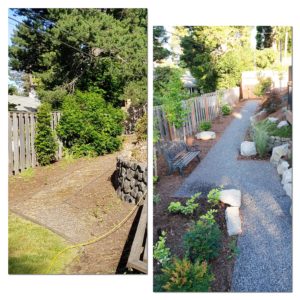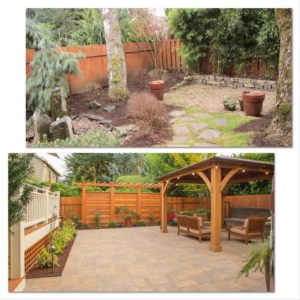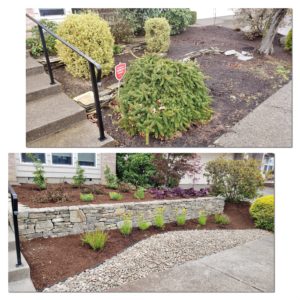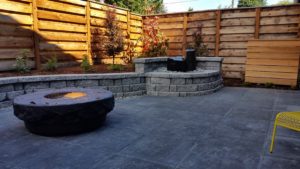Are your dreams bigger than your yard? 10 tips to maximize your space.
When it comes to landscape design, the sky really is the limit. And with a multitude of styles, materials, plants, and special elements to choose from, we understand why your imagination might get a little carried away. That’s ok. Dreaming is the best place to start when it comes to creating a landscape that is just right for you. But when it comes to making sure your dream landscape is perfect for your yard, there are key things to consider and space is one of the most important! So, we’ve compiled our top 10 tips to maximize your yard space.
Tip #1: Functionality
It all comes down to how you want to use the space. Yes, you can have a multi-purpose yard—in fact, we encourage that—but pay attention to the different features you want in your design, how well they work together and how individual elements impact the functionality of the space. 
Tip #2: Priorities
You may have a laundry list of features you think you want to incorporate in your design, but more is not always better. Whether you have a small or an expansive yard to work with, too many features will compete for attention and overcrowd your space. The end result is a cluttered look lacking in purpose that may make the space feel smaller. Decide what matters most before you jump in so you can make smart decisions when it comes time to either include or eliminate elements from your plans.
Tip #3: Maintenance
Small size does not necessarily mean less work. So, it is important to decide upfront how much time and money you are willing to spend keeping up your landscape and all the various elements in it—plants, water features, lighting, decks, flowerbeds, etc. There are degrees of maintenance from low to high and knowing how much time you are willing to commit will help you through the selection process.
Tip #4: Boundaries & Setbacks
Before embarking on any design, you need to know exactly how much useable space you actually have to work with, and this is not always the outer edge of your property line. Be sure you know where your property lines are and also any setback restrictions. A setback is the distance from your property line within which building is prohibited. Depending on what you have in mind for your yard, setbacks can reduce the amount of usable space.
Tip #5: Scale
As you are selecting features, from plants to hardscapes to furniture and artistic elements, remember size matters! In a small yard, you need to pay even more attention to size and scale. If the elements are too large they will look out of place, can diminish the functionality of your space, and can actually make your yard feel even smaller.
Tip #6: Portability
A simple way to maximize your space is to use portable features. Outdoor kitchens with the built-in grill or woodfired pizza oven sound great, but in reality, can take up a lot of room and not provide a lot of return for the number of times they are actually used throughout the year. The same can be said for fire pits and outdoor fireplaces. A portable option may be a better solution and will give your space more versatility and flexibility throughout the seasons. Container gardens are another portable feature and can be configured and reconfigured as needed, making them a great way to maximize space without compromising style.
Tip #7: Layers
Layers in a landscape create depth and the illusion of more space. Layering is also an excellent way to add both vertical and horizontal interest with different textures, colors, and shapes. Varying plant heights, terraced gardens, retaining walls, trellises, and arbors are strategic design considerations that can help a small space feel bigger. For sloping yards, tiered retaining walls can serve the dual purpose of creating layers and depth, while also eliminating the need for permits and engineering a larger wall would require.
Tip #8: Multi-Purpose
Elements that can serve multiple purposes will help to maximize the functionality of a small space, while also delivering on a design aesthetic. For example, retaining walls can also serve as seating, benches can also provide storage, and fire pits can also be dining tables.
Tip #9: Terrain
Slopes and uneven terrain can have a huge impact on the amount of usable space in a yard, especially on a smaller lot. Leveling out your yard with retaining walls and terraces can be a practical solution to maximize space and provide more visual interest.
Tip #10: Have Plan
Creating a beautiful and functional yard has less to do with how much room you have to work with than what and how much you decide to put into the room you have. No matter the size of the landscape or the size of the budget, to make it all come together in the best way possible, you need a plan. Gather all of your ideas, write down your wish list, outline your priorities, determine your budget, and then make a plan.
If you are stumped on how to make a plan, hire a designer to help you pull it all together. A professional landscape designer can walk you through different scenarios and options to help you find the best solutions to fit the physical constraints of your yard while bringing your vision to life. With a well thought out plan, you will also save yourself time, frustration, and money.
Need help getting started? Our experienced design professionals at Landscape East & West will work with you to create a plan that is right for you and your yard. Contact us today to learn more about our design-build process and how we can help you.

